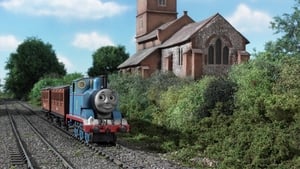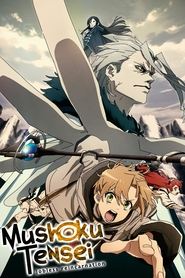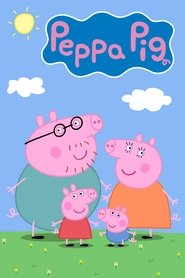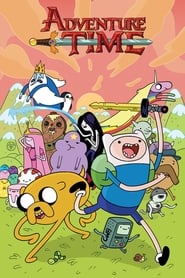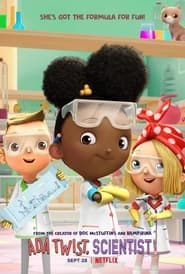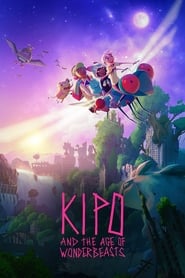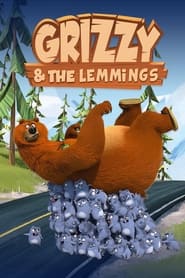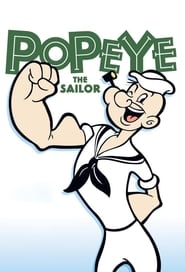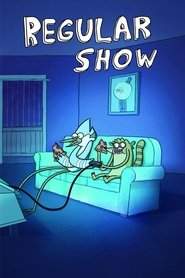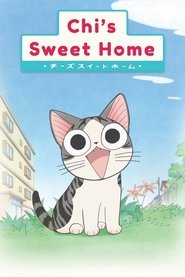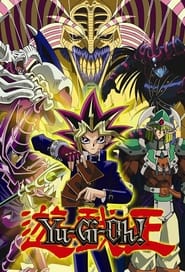
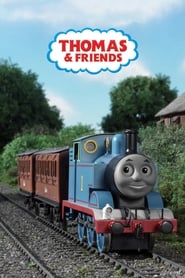
Video trailer
Synopsis
Synopsis
Thomas & Friends (originally Thomas the Tank Engine & Friends) is a cult British children’s show on television that is based on The Railway Series books written by the Reverend W. Awdry and later his son, Christopher Awdry. The show is about an anthropomorphic group of locomotives as well as railway automobiles on the island called Sodor and is under the supervision of Sir Topham Hatt (also known as “The Fat Controller”).

Every episode usually has problems such as broken tracks, miscommunications, rivalry, and mechanical malfunctions that Thomas and his fellow engineers must solve with each other, gaining lessons in collaboration, responsibility, and friendship. Over the years, the series has grown, introducing new characters, fresh animation styles, and broader global settings.
In 2021, following the run of its main series for several seasons, Thomas & Friends changed to a new series named Thomas & Friends: All Engines Go, which uses a fresh design and narrative style.
Quick Show Information
| Field | Detail |
|---|---|
| Original Title/ Alternate Title | Thomas the Tank Engine & Friends (later Thomas & Friends) |
| Based on | The Railway Series by Rev. W. Awdry / Christopher Awdry |
| Creator or Adaptation | Britt Allcroft (adapted for TV) |
| Studio / Production | Created by Britt Allcroft. The Railway Series adaptation, later, under Mattel ownership |
| Original Run | 1984 – 2021 (main series) |
| Seasons, Episodes and Seasons | 24 Series (seasons), films, and specials |
| Time of Runtime | Typically, it is 10-11 minutes per episode |
| Reboot / Continuation | Thomas & Friends: All Engines Go (from 2021 and onwards) |
| Current Status | The first series ended, but it is currently running until 2025. |
The show has been adapted extensively, using a variety of voice actors, narrators, and dubs from many countries, making it a universal kids’ favorite.
Summary of Plot
Since Thomas & Friends is episodic, not driven by narrative, “plot” is more about structure, repeating themes, and occasionally episodes. Here is a brief overview of the process used by the show, along with some interesting advancements.
Episode Structure and Formula
The majority of episodes follow a pattern:
- Introduction /Setup
The show begins with normal railroad operations: Thomas or another engine is assigned a job (deliver coaches or shunt vehicles, assist in maintenance). - Interference / Issue
A thing goes wrong. It could be a miscommunication or behavior, a damaged track, or an event that is weather-related. - Rising Conflict
The problem gets worse as an engine becomes stuck, a signal is lost, or two engines race too intensely. - Resolution / Lesson
Through friendship, cooperation, and the guidance of (often through Sir Topham Hatt or more knowledgeable engines), the order is restored, and the moral lessons are learnt.
The stories are simple and designed to appeal to preschoolers and early childhood viewers, and emphasize the lessons of life in a soft and non-threatening manner.
Character Roles & Interactions
- Thomas is the main engine interesting, sometimes excited, and sometimes a little naughty.
- Other Steam Engines: Edward, Henry, Gordon, Percy, James, Toby, Emily, and more.
- Diesel/Troublesome Engines Sometimes unfriendly or misunderstood.
- Sir Topham Hatt (“The Fat Controller”) supervises trains, mediates conflict, and distributes assignments.
- Vehicles/Non-Engine Characters, such as trucks, coaches, and crane vehicles, are sometimes featured.
Through numerous episodes, the show examines topics like teamwork, accepting assistance, responsibility, and humility.
Notable New Developments and Specials
- The series has made numerous feature-length films and specials, including Thomas & Friends: The Great Race (2016), Sodor’s Legend of the Lost Treasure (2015), as well as Big World! Big Adventures! (2018).
- Big World! Big Adventures! Marked a major overhaul: Thomas visits new countries, and the series started to grow internationally in its settings and in the variety of settings.
- With the reboot of All Engines Go, the show is now in an edgier, contemporary cartoon style and departs from the traditional model/narration format.
While there was no major long-term storyline in the first series, later seasons and the new version introduced more continuity, changing characters’ arcs along with themes about the global community.
Themes and Analyses
However, Thomas & Friends is targeted at children of a young age. The book focuses on important themes that are wrapped up in simple stories.
Responsibility and Duty
Engines learn that each task, whether small or large, is important. Even the shunting of one or two freight vehicles is a part of a bigger network. Making mistakes can result in consequences. The show inspires children to be accountable and work hard.
Friendship, Teamwork & Cooperation
Many shows show how the combination of efforts and respecting one another can lead to better results. Engines work together by sharing tasks or helping out fellow engines in need.
Humility, Mistakes & Forgiveness
Thomas frequently makes mistakes (being too fast, not following rules). The show shows how to acknowledge mistakes and apologize for them, as well as repair damage. It shows that anyone can be taught from mistakes.
Inclusion & Inclusion
In the past, Thomas & Friends has attempted to diversify characters by introducing engines from various regions of the globe (e.g., Nia of Kenya, Ashima from India). The media increasingly incorporates gender-balanced and multicultural messages.
Identity and The Purpose
Episodes may look at how engines feel valuable or how they can change their roles or find their place in the rail system. This is a way to reflect on one’s own contributions and the value of each.
Growth & Change
While the series isn’t often radical, it is a gradual process of changes (new engines changing routes, technological enhancements), which is a sign of progress and adaptation. The change to “All Engines Go” represents a new vision for children.
Moral Education Through Fiction
In presenting situations using the use of machines instead of people, it is a way to teach empathy, conflict resolution, as well as honesty and perseverance in a visually captivating and low-risk manner.
From the perspective of media studies, Thomas & Friends is a great example of how programming for children can incorporate moral and social concepts in familiar, comforting, and recurring styles.
Criticism and Controversy
While it’s a hugely loved show, Thomas & Friends is not exempt from critique and discussion. Here are the main points brought up by critics, fans, and analysts:
Modernization and loss of Charm
A few long-time fans and purists claim that the reboot of The All Engines Go is missing its “magic” from the original series. Britt Allcroft, the original show’s adapter, has reportedly criticised the reboot, claiming that it “lacks the enchantment” from the original.
The removal of classic episodes / Rights and Accessibility
Many fans complain that the old episodes are hard to obtain legally and that some older versions or dubs are being blocked or removed. The shift away from older formats (model trains or the narration format) has riled nostalgic viewers.
Simplification/ Didactic Approach
The show is often criticized as too moralistic or simplistic, as issues are resolved in brief time periods, often with idealized behaviour that can feel forced. In today’s discourse about children’s media, the overly didactic content can be criticised for not reflecting the actual complex issues.
Representation & Gender Balance
Although the franchise has increased its diversification, the past had an engine lineup that was predominantly male-dominated. The introduction of female-oriented engines (like Nia and Rebecca) in the latter seasons was thought of as long overdue. Some critics believe that these changes were imposed from the outside or driven by marketing, and not natural story-driven changes.
Visual / Style Shifts and Audience Alienation
The style of animation that changes, such as models, CGI, or a cartoon reboot, occasionally irritates those who prefer older aesthetics. The change in tone, pace, and comedy in the series All Engines Go isn’t universally popular with older viewers.
Broadcast Rights, Networks, Availability, and Accessibility
The broadcasting platforms for the show have changed over the years. Many fans complain that the original Thomas & Friends (or its seasons) was not available in some areas due to changes to rights. Many express their regret over the demise of programs aired on public television.
Despite criticisms, Thomas & Friends is widely praised for its positive message and its constant appeal to children from all generations.
Cinematography and Style
While it’s a kids’ animated series and not a live-action movie, Thomas & Friends has been through distinct stylistic and visual periods. Below is a look at the evolution of its aesthetic and style.
Original Model/Narration Era (1984-2000s)
The initial seasons utilized model trains, real sets, and live-action photography. This gave the show a real-feeling, tactile feel that was loved by the viewers. Narration (e.g., Ringo Starr or George Carlin) lent the impression of a character, and one person was the one to tell the story. The camera’s physical motion, tracking smoke, and real-world lighting created a documentary-like miniature train.
CGI/Hybrid Transition Phases
In the course of time, the show moved towards CGI (computer-generated images) or hybrid format models for backgrounds, Digital engines, and even full CGI. This enabled more dramatic camera movements, more expressive faces, and a variety of settings. However, some viewers feel that it lacks the appeal of real models.
Comical Reboot (All Engines Go)
The new version of Thomas & Friends: All Engines Go introduces a completely modern, 2D/cartoon-style look. It’s more vibrant, sleeker, and more stylized with exaggerated facial expressions along with simplified backgrounds and funnier timing. This shift is in the stylistic tone of the film to appeal to a younger generation of kids who are used to contemporary animation styles.
Color, Lighting & Visual Mood
In all the different versions of the show, colour palettes assist in determining tone: early episodes are characterized by natural lighting, muted tones, and earth tones (tracks or countryside). In more dramatic scenes, lighting can be darkened or emphasize tension. The reboot has brighter and more vibrant shades that dominate, reflecting an energy and a playful tone.
Animation & Motion
In the model era, movement is planned, using cameras, dollies, and physical limitations on movement. The latter CGI permits cameras to stitch and squash, along with dynamic angles. The heightened movement of The All-Engines-Go Movie features cartoon-like exaggeration; engines can bounce, stretch, or even perform funny stunts.
Framing, Camera Angles & Perspective
Classic series shot from eye-levels of adult height, highlighting the physical size of stations, tracks, and mountains. Close-ups are not common as action is usually shown in mid-distance. In contemporary styles, greater close-ups, high/low angles, as well as motion are used to highlight the character’s expressions and emotions.
Symbolic and Visual Motifs
Recurring visual motifs include:
- Steam and smoke in expressions of emotions (excitement and anger)
- Junctions and tracks symbolise the possibilities/routes.
- Tunnels, bridges, and stations are dramatic or transitional locations.
- Weather elements (fog, rain) to indicate mood or a challenge
- Tracks, wheels crossing gates, wheels to tie the story to the metaphor of railways
From a design standpoint, each engine is distinctive in patterns, colors, and numbers that aid in identification branding, as well as visual memory for children.
Editing and Pacing
The first episodes employ simple cuts that show the progression from task to resolution. In later animation stages, editing speeds up and includes more montages, cutting, cross-cutting, and reaction shots to maintain engagement. The reboot is likely to use faster cuts and more visuals per minute.
All in all, the development of the Thomas & Friends style is a reflection of the evolution of technology, audience expectations, and brand. Although some fans aren’t keen on the old physical model, the changes are normal reactions to the new media environment.
Cultural Impact
Thomas & Friends is much more than just a kids’ show. It’s an institution of global culture. The influence of the show spans generations. Here are some of the most important aspects of its influence on the world.
Longevity and Global Reach
Since the show’s debut on television in 1984 (adapting the earlier novels), Thomas & Friends has been aired in more than 185 countries and translated into numerous languages. The show’s popularity over the years is proof of its timeless appeal.
Branding and Selling
Thomas is now a major toy set, railway sets, video games, clothing, book, and theme park company. Thomas is a major element of Mattel’s children’s portfolio. Thomas is a well-known character. Thomas is a staple of the early years of childhood.
Nostalgia and Intergenerational Appeal
Many parents who enjoyed watching Thomas & Friends as children are now sharing the show with their children. The intergenerational bond boosts emotional bonds, nostalgia, and brand consistency.
Effects on children’s programming
Thomas & Friends proved that a bare concept (talking trains) can develop into a lasting moral and educational storytelling format. The success of the show likely inspired other shows for children to adopt human-like characters, a problem-solving format, as well as moral lessons.
Representation & Inclusion Advances
In recent times, the show has made conscious efforts to improve the diversity of its engines (e.g., adding more female-oriented engines and multicultural engines). It also introduces an autistic character, Bruno Brake Car, designed to offer a positive portrayal and understanding of autism to viewers.
Legacy and Archival Attention
In 2025, an unreleased episode from 1983 (“Down to the Miner”) with the narration of Ringo Starr was rebuilt and released to celebrate Thomas’s birthday. The attention paid to the archive demonstrates the huge fanbase and the show’s importance in the past.
Critical Discourse and Fan Discourse
Thomas fandom is lively. Fans debate episodes, dubs, and restorations, missing content as well as show evolution and controversy (e.g., the removal of old episodes). The show is being studied as a model of how the media that children consume changes and evolves in response to societal changes.
Reboot Reception & Legacy Debates
The switch into the All Engines Go version caused debate among fans about whether the new version was a new development or just simply a slight change. Some critics claim it has lost the original’s appeal, while supporters claim that it modernizes Thomas to appeal to a younger generation. These debates show how beloved franchises need to balance legacy with modernization.
In conclusion, Thomas & Friends is one of the longest-running and most influential children’s entertainment properties not just a TV show, but a cultural phenomenon.
Where to watch the Guts?
“Where to Watch “Where to Watch (Guts? )” I consider you to be asking about legal streaming or viewing sources. Here are the best platforms and ways for watching Thomas & Friends:
- Netflix. Netflix: Many regions offer Thomas & Friends seasons.
- Apple TV -The show is featured in the catalog of Apple TV.
- Amazon Prime Video: The “Thomas and Friends Classic” is available on Prime in certain markets.
- Official YouTube Thomas and Friends Channels. The official channel broadcasts full traditional episodes as well as compilations or other content.
- DVD, Blu-ray, and Physical Media – Sets of boxes, collections of the original episodes, and special editions continue to be available in a variety of regions.
- Broadcast/ Local TV Networks -In certain countries, public or children’s television networks are still licensed to broadcast Thomas episodes, but the availability changes.
- Reboot is available. The availability of Reboot is- Every Engine Go is available on streams on streaming services (e.g., Netflix, in accordance with your region).
Note: What series or editions (classic vs. reboot) are available is contingent on the country’s licensing. If you provide me with the country you reside in (e.g., Pakistan), I will determine which platform is currently offering Thomas & Friends there.
Frequently Answered Questions
Q: Is Thomas & Friends still being developed?
The original series was cancelled in 2021. It was relaunched in 2021. Thomas & Friends: All Engines Go is the latest version.
Q: What’s changed in the HTML0 code in all Engines Go as compared to the previous?
The new version uses 2D animation, a more humorous tone, and a more rapid pacing, and is stylistically different from the narration/model format.
Q: Who invented Thomas & Friends?
The show was adapted for TV from Britt Allcroft, who adapted The Railway Series by Rev. W. Awdry and his son Christopher.
Q: Is the program educational or suitable for children?
Yes, it is typically rated for children (TV-Y or similar) and is designed to help teach values, logic, co-operation, and basic problem-solving skills through stories.
Q: Why are certain classic episodes not available anymore?
License changes or restrictions on copyrights, as well as decisions taken by owners of rights (Mattel), have resulted in certain episodes being removed or blocked.
Conclusion
Thomas & Friends is much more than a basic train-themed children’s program -it’s a piece of the world’s cultural heritage and a great example of how stories aimed at children have moral value, and also a show that has grown with the changing media landscapes.
From its beginnings of model trains and single-narrator stories and on to CGI hybrids, and finally the full-on reboot of cartoons, Thomas has adapted while keeping the core values of growing, friendship, accountability, and helping others. Although debates continue over whether the newer versions keep “the magic of the original,” it’s clear that Thomas has inspired generations of children, giving life lessons along the tracks of imagination.
Original title Thomas & Friends
TMDb Rating 6.782 133 votes
First air date Oct. 09, 1984
Last air date Jan. 20, 2021
Seasons 26
Episodes 584
Average Duration 22 minutes



